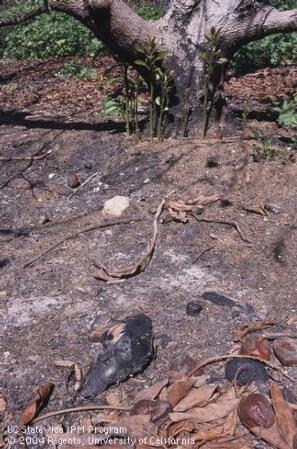The wildfires in San Diego and Ventura Counties during the fall of 2003 were certainly devastating to many avocado groves adjacent to burning native chaparral. Many of the avocado trees were singed in the canopy without extensive damage to the large scaffold branches; these trees will re-grow new foliage with some relatively minor pruning to clear out smaller dead branches. However, other groves have had extensive damage, complete with charring of the bark in the trunk and boiling of the sap through the bark of the trunk. In these cases, the sap became hot enough to steam the cambium layer (the layer of living cells just beneath the bark), killing the tree above the soil line.
In the latter case, the tree above the soil line is dead, but the roots are still alive. Beginning about the first of March 2004, we have noticed that many of these trees are sending up rootstock suckers near the trunk. If left to grow un-grafted, these suckers will become an avocado tree, but not a known cultivar. The question is: should these burned trees be removed and replanted with a new tree? Or should a sucker be tip-grafted back to a known cultivar?
Sucker grafting in avocado is a well-known practice and has been used extensively in the industry when a grower desired to change cultivars. Generally, the tree is cut down leaving a threefoot stump, which is used as a stake for the new tree. A strong sucker growing from the base of the tree is selected (the sucker should be about 3/4 to 1" in diameter and stiff, not rubbery), and the other smaller suckers should be removed. The sucker is cut with a horizontal cut about 6-8" above the soil line, a 2”vertical slit is made down through the center of the sucker, and 3" to 4" long piece of budwood, cut like an arrowhead at the bottom end, is slipped into the slit, matching the cambium layers together on at least one side, and preferably on both sides. The graft is wrapped tightly with grafting tape, and the entire budstick is wrapped with Parafilm to prevent moisture loss, and grafting tape is used to tie the new grafted sucker to the stump (used as a stake).
Advantages from sucker grafting (as opposed to planting a new tree).
- Sucker grafting is cheaper. As recently quoted by a grafter in Fallbrook, sucker grafting usually costs about $2 per tree after the tree has been cut down to a 3 foot stump. If the grafter supplies the budwood and grafting tape, the price will probably be $2.50 per tree. If the grafter has to travel away from Fallbrook, the price will be higher according to the distance traveled. A new replacement tree will cost about $14 on a seedling rootstock, or $19-22 on a clonal rootstock. The labor cost for planting the new tree would be about $2.00 per tree. These costs do not include cutting down the older burned tree, or follow-up care for the young tree.
- The older, burned avocado tree has an extensive root system with a lot of stored energy. When the sucker graft begins to grow it usually grows very rapidly, much faster than a young replant tree. The sucker grafted tree should start to set fruit two years after grafting.
Disadvantages from sucker grafting.
- We are assuming that the sucker-grafted tree is healthy and does not have root rot or some other disease. If the older tree has root rot, it would be better to remove the old tree and replant with a new tree grown on one of the newer root-rot tolerant clonal rootstocks.
- In the system described above, the trunk is used as a stake. When the new tree grows enough to be selfsupporting, the old stump should be cut down close to the ground. The stump should be slightly sloped to drain water away from the new tree. This takes some careful chainsaw work.
- Suckers. Until the new tree gains strength and starts to shade the old stump, there will be other suckers emerging. These must be removed or they will take over and shade the grafted sucker.
 Replant or Sucker-Graft?
Replant or Sucker-Graft?